Multiple signaling pathways regulate cell surface expression and activity of the excitatory amino acid carrier 1 subtype of Glu transporter in C6 glioma
- PMID: 9502808
- PMCID: PMC6793087
- DOI: 10.1523/JNEUROSCI.18-07-02475.1998
Multiple signaling pathways regulate cell surface expression and activity of the excitatory amino acid carrier 1 subtype of Glu transporter in C6 glioma
Abstract
Neuronal and glial sodium-dependent transporters are crucial for the control of extracellular glutamate levels in the CNS. The regulation of these transporters is relatively unexplored, but the activity of other transporters is regulated by protein kinase C (PKC)- and phosphatidylinositol 3-kinase (PI3K)-mediated trafficking to and from the cell surface. In the present study the C6 glioma cell line was used as a model system that endogenously expresses the excitatory amino acid carrier 1 (EAAC1) subtype of neuronal glutamate transporter. As previously observed, phorbol 12-myristate 13-acetate (PMA) caused an 80% increase in transporter activity within minutes that cannot be attributed to the synthesis of new transporters. This increase in activity correlated with an increase in cell surface expression of EAAC1 as measured by using a membrane-impermeant biotinylation reagent. Both effects of PMA were blocked by the PKC inhibitor bisindolylmaleimide II (Bis II). The putative PI3K inhibitor, wortmannin, decreased L-[3H]-glutamate uptake activity by >50% within minutes. Wortmannin decreased the Vmax of L-[3H]-glutamate and D-[3H]-aspartate transport, but it did not affect Na+-dependent [3H]-glycine transport. Wortmannin also decreased cell surface expression of EAAC1. Although wortmannin did not block the effects of PMA on activity, it prevented the PMA-induced increase in cell surface expression. This trafficking of EAAC1 also was examined with immunofluorescent confocal microscopy, which supported the biotinylation studies and also revealed a clustering of EAAC1 at cell surface after treatment with PMA. These studies suggest that the trafficking of the neuronal glutamate transporter EAAC1 is regulated by two independent signaling pathways and also may suggest a novel endogenous protective mechanism to limit glutamate-induced excitotoxicity.
Figures
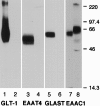


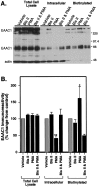



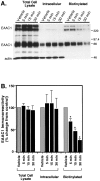
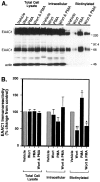
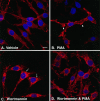
Similar articles
-
Rapid stimulation of EAAC1-mediated Na+-dependent L-glutamate transport activity in C6 glioma cells by phorbol ester.J Neurochem. 1996 Aug;67(2):508-16. doi: 10.1046/j.1471-4159.1996.67020508.x. J Neurochem. 1996. PMID: 8764574
-
Inhibition of the glutamate transporter EAAC1 expressed in Xenopus oocytes by phorbol esters.Brain Res. 2001 Sep 28;914(1-2):196-203. doi: 10.1016/s0006-8993(01)02802-5. Brain Res. 2001. PMID: 11578612
-
Platelet-derived growth factor rapidly increases activity and cell surface expression of the EAAC1 subtype of glutamate transporter through activation of phosphatidylinositol 3-kinase.J Biol Chem. 2000 Feb 18;275(7):5228-37. doi: 10.1074/jbc.275.7.5228. J Biol Chem. 2000. PMID: 10671571
-
Differential regulation by protein kinases of activity and cell surface expression of glutamate transporters in neuron-enriched cultures.Neurochem Int. 2005 Mar;46(4):337-46. doi: 10.1016/j.neuint.2004.10.006. Epub 2005 Jan 13. Neurochem Int. 2005. PMID: 15707698
-
Reconstitution of GABA, Glycine and Glutamate Transporters.Neurochem Res. 2022 Jan;47(1):85-110. doi: 10.1007/s11064-021-03331-z. Epub 2021 Apr 27. Neurochem Res. 2022. PMID: 33905037 Free PMC article. Review.
Cited by
-
Morphine induces ubiquitin-proteasome activity and glutamate transporter degradation.J Biol Chem. 2008 Aug 1;283(31):21703-13. doi: 10.1074/jbc.M800809200. Epub 2008 Jun 6. J Biol Chem. 2008. PMID: 18539596 Free PMC article.
-
Internalization and degradation of the glutamate transporter GLT-1 in response to phorbol ester.Neurochem Int. 2008 Mar-Apr;52(4-5):709-22. doi: 10.1016/j.neuint.2007.08.020. Epub 2007 Sep 6. Neurochem Int. 2008. PMID: 17919781 Free PMC article.
-
Translocation of glutamate transporter subtype excitatory amino acid carrier 1 protein in kainic acid-induced rat epilepsy.Am J Pathol. 2003 Aug;163(2):779-87. doi: 10.1016/S0002-9440(10)63705-4. Am J Pathol. 2003. PMID: 12875997 Free PMC article.
-
Activation of extrasynaptic NMDA receptors induces a PKC-dependent switch in AMPA receptor subtypes in mouse cerebellar stellate cells.J Physiol. 2007 Sep 1;583(Pt 2):537-53. doi: 10.1113/jphysiol.2007.136788. Epub 2007 Jun 21. J Physiol. 2007. PMID: 17584840 Free PMC article.
-
Complementary neuronal and glial expression of two high-affinity glutamate transporter GLT1/EAAT2 forms in rat cerebral cortex.Histochem Cell Biol. 2003 Jun;119(6):425-35. doi: 10.1007/s00418-003-0530-7. Epub 2003 May 20. Histochem Cell Biol. 2003. PMID: 12756574
References
-
- Attwell D, Barbour B, Szatkowski M. Nonvesicular release of neurotransmitter. Neuron. 1993;11:401–407. - PubMed
-
- Casado M, Bendahan A, Zafra F, Danbolt NC, Gimenez C, Kanner BI. Phosphorylation and modulation of brain glutamate transporters by protein kinase C. J Biol Chem. 1993;268:27313–27317. - PubMed
Publication types
MeSH terms
Substances
Grants and funding
LinkOut - more resources
Full Text Sources
Other Literature Sources
Research Materials
Miscellaneous
